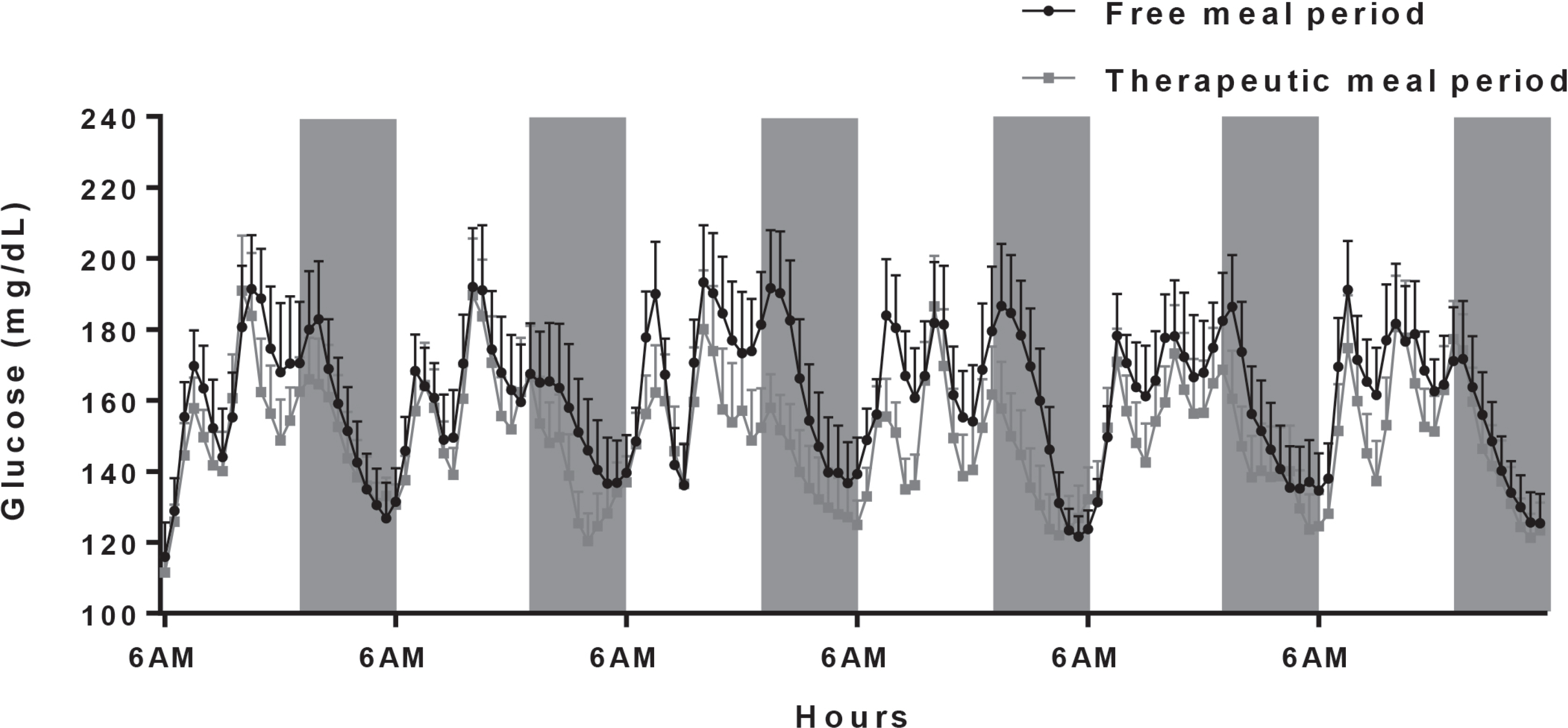J Korean Diabetes.
2020 Mar;21(1):46-54. 10.4093/jkd.2020.21.1.46.
Glucose-Lowering Effect of Home-Delivered Therapeutic Meals in Patients with Type 2 Diabetes
- Affiliations
-
- 1Division of Endocrinology and Metabolism, Department of Internal Medicine, Korea
- 2Diabetes Center, Asan Medical Center, University of Ulsan College of Medicine, Seoul, Korea
- KMID: 2506774
- DOI: http://doi.org/10.4093/jkd.2020.21.1.46
Abstract
- Background
Medical nutrition therapy is a fundamental part of diabetes management; however, it is very difficult for patients to maintain the recommended diet programs. We investigated whether providing home-delivered therapeutic meals designed by registered dietitians could be useful in lowering blood glucose levels in patients with type 2 diabetes.
Methods
During a 12-day study period, we monitored the blood glucose levels of 19 patients with type 2 diabetes by continuous glucose monitoring. For the first six days, the participants maintained their usual lifestyles and were allowed to eat freely (free meal period). During the last six days, two out of the three main meals per day were replaced with home-delivered therapeutic meals designed for diabetes management (therapeutic meal period), during which snacks and exercise were freely allowed. Blood glucose levels and estimated glycated hemoglobin (eHbA1c) were compared between the two periods.
Results
Between the free meal period and the therapeutic meal period, mean blood glucose level and eHbA1c dropped by 11.9 mg/dL (P < 0.001) and 0.4% (P = 0.002), respectively. These results were mainly due to the decrease in postprandial glucose levels rather than preprandial glucose levels.
Conclusion
Providing home-delivered therapeutic meals designed for diabetes management was effective in lowering the blood glucose levels in patients with type 2 diabetes.
Figure
Cited by 1 articles
-
Blood Sugar Management Related to Home Meal Replacement and Delivery Meal Services among Patients with Diabetes Mellitus
Min Young Noh
J Korean Diabetes. 2021;22(2):142-146. doi: 10.4093/jkd.2021.22.2.142.
Reference
-
1. Won JC, Lee JH, Kim JH, Kang ES, Won KC, Kim DJ, Lee MK. Diabetes fact sheet in Korea, 2016: an appraisal of current status. Diabetes Metab J. 2018; 42:415–24.
Article2. Aschner P. New IDF clinical practice recommendations for managing type 2 diabetes in primary care. Diabetes Res Clin Pract. 2017; 132:169–70.
Article3. Kim MK, Ko SH, Kim BY, Kang ES, Noh J, Kim SK, Park SO, Hur KY, Chon S, Moon MK, Kim NH, Kim SY, Rhee SY, Lee KW, Kim JH, Rhee EJ, Chun S, Yu SH, Kim DJ, Kwon HS, Park KS; Committee of Clinical Practice Guidelines, Korean Diabetes Association. 2019 Clinical practice guidelines for Type 2 diabetes mellitus in Korea. Diabetes Metab J. 2019; 43:398–406.
Article4. American Diabetes Association. 5. Lifestyle management: Standards of Medical Care in Diabetes-2019. Diabetes Care. 2019; 42(Suppl 1):S46–60.5. Franz MJ, MacLeod J, Evert A, Brown C, Gradwell E, Handu D, Reppert A, Robinson M. Academy of nutrition and dietetics nutrition practice guideline for type 1 and type 2 diabetes in adults: systematic review of evidence for medical nutrition therapy effectiveness and recommendations for integration into the nutrition care process. J Acad Nutr Diet. 2017; 117:1659–79.
Article6. Matsumura M, Nakatani Y, Tanka S, Aoki C, Sagara M, Yanagi K, Suzuki K, Aso Y. Efficacy of additional canagliflozin administration to type 2 diabetes patients receiving insulin therapy: examination of diurnal glycemic patterns using continuous glucose monitoring (CGM). Diabetes Ther. 2017; 8:821–7.
Article7. Nathan DM, Kuenen J, Borg R, Zheng H, Schoenfeld D, Heine RJ; A1c-Derived Average Glucose Study Group. Translating the A1C assay into estimated average glucose values. Diabetes Care. 2008; 31:1473–8.
Article8. Battelino T, Danne T, Bergenstal RM, Amiel SA, Beck R, Biester T, Bosi E, Buckingham BA, Cefalu WT, Close KL, Cobelli C, Dassau E, DeVries JH, Donaghue KC, Dovc K, Doyle FJ 3rd, Garg S, Grunberger G, Heller S, Heinemann L, Hirsch IB, Hovorka R, Jia W, Kordonouri O, Kovatchev B, Kowalski A, Laffel L, Levine B, Mayorov A, Mathieu C, Murphy HR, Nimri R, Nørgaard K, Parkin CG, Renard E, Rodbard D, Saboo B, Schatz D, Stoner K, Urakami T, Weinzimer SA, Phillip M. Clinical targets for continuous glucose monitoring data interpretation: recommendations from the international consensus on time in range. Diabetes Care. 2019; 42:1593–603.
Article9. Chehregosha H, Khamseh ME, Malek M, Hosseinpanah F, Ismail-Beigi F. A view beyond HbA1c: role of continuous glucose monitoring. Diabetes Ther. 2019; 10:853–63.
Article10. Chaudhury A, Duvoor C, Reddy Dendi VS, Kraleti S, Chada A, Ravilla R, Marco A, Shekhawat NS, Montales MT, Kuriakose K, Sasapu A, Beebe A, Patil N, Musham CK, Lohani GP, Mirza W. Clinical review of antidiabetic drugs: implications for type 2 diabetes mellitus management. Front Endocrinol (Lausanne). 2017; 8:6.
Article11. Palanisamy S, Yien ELH, Shi LW, Si LY, Qi SH, Ling LSC, Lun TW, Chen YN. Systematic review of efficacy and safety of newer antidiabetic drugs approved from 2013 to 2017 in controlling HbA1c in diabetes patients. Pharmacy (Basel). 2018; 6:E57.
Article12. Giugliano D, Maiorino M, Bellastella G, Chiodini P, Esposito K. Relationship of baseline HbA1c, HbA1c change and HbA1c target of < 7% with insulin analogues in type 2 diabetes: a meta-analysis of randomised controlled trials. Int J Clin Pract. 2011; 65:602–12.13. Kelly RB. Diet and exercise in the management of hyperlipidemia. Am Fam Physician. 2010; 81:1097–102.14. Chalasani N, Younossi Z, Lavine JE, Charlton M, Cusi K, Rinella M, Harrison SA, Brunt EM, Sanyal AJ. The diagnosis and management of nonalcoholic fatty liver disease: Practice guidance from the American Association for the Study of Liver Diseases. Hepatology. 2018; 67:328–57.
Article
- Full Text Links
- Actions
-
Cited
- CITED
-
- Close
- Share
- Similar articles
-
- Glucose Lowering Effect of SGLT2 Inhibitors: A Review of Clinical Studies
- Nutrition Recommendations for Special Diabetic Situations
- Qualitative study on home delivery meal services for the elderly
- DPP-4 Inhibitors as a New Option for the Management of Type 2 Diabetes
- Clients' Handling and Consumption of Home-delivered Meals at Home and Their Perceptions on Home-Delivered Meal Services for Older Adults


